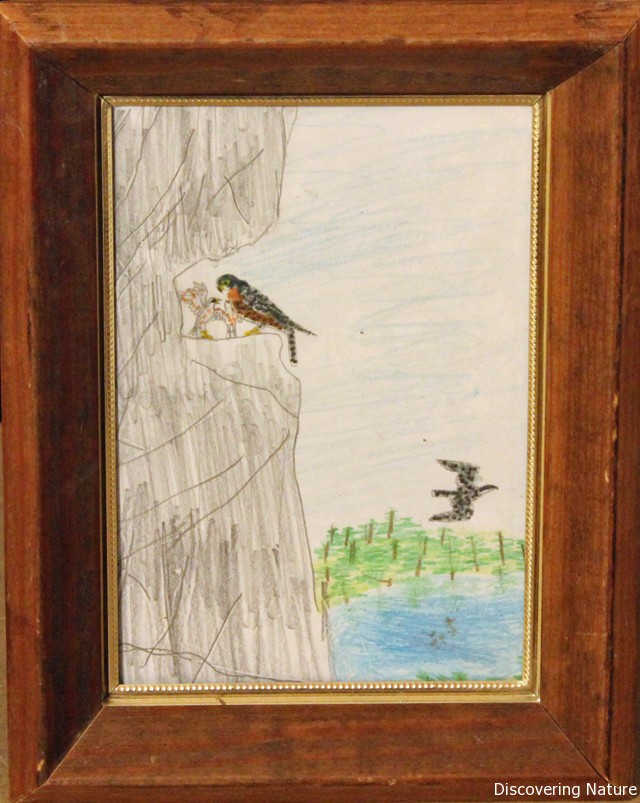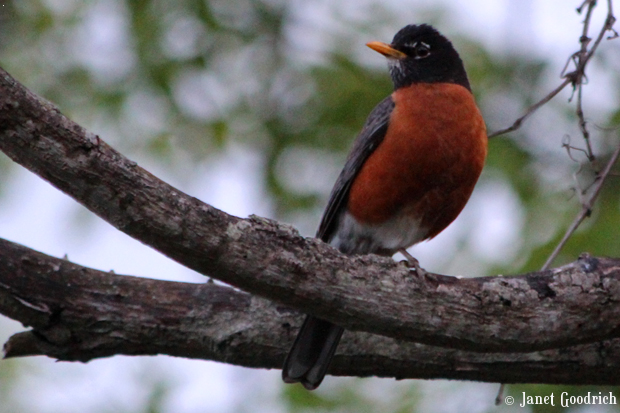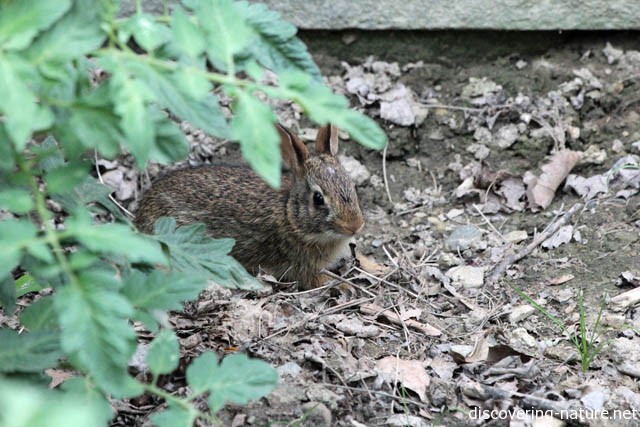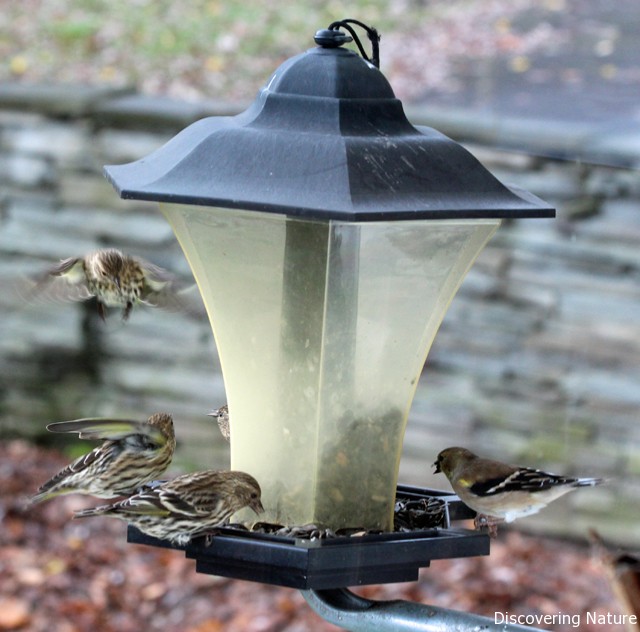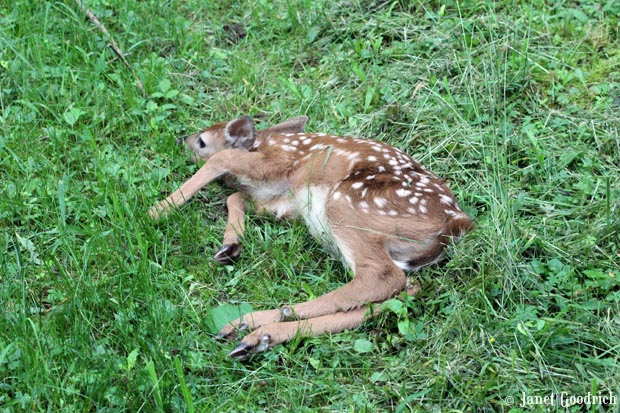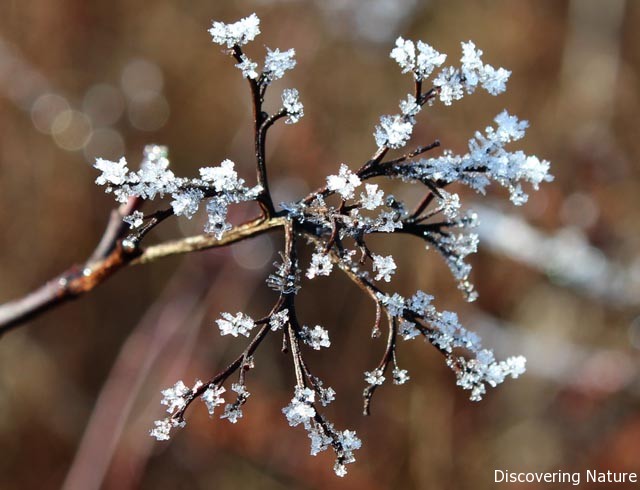-
Four-legged feeder visitor
I saw this gray fox one evening out by our bird feeder and it ran away. I figured it was hunting for an unwary ground-feeding bird. But the next morning it reappeared, and it was eating the bird seed on the ground.
I’ve never heard of a fox doing this. Live and learn!
-
Hungry
Everyone was feeding their young this week when we took our walk in the woods. This was probably a once in a lifetime sight… I think Mrs. Doe had a fast getaway in mind, but she tolerated her two hungry fawns for a minute before leaping cleanly over them and leading them quickly into the woods.
The redwinged blackbird babies were hungry too…
…as were the orioles.
Other sights…

Indigo bunting 
Daisy 
“Indian paintbrush” 
Red-eyed vireo That’s just a sampling… There were many other sights and sounds, too. This time of year it’s impossible to document them all.
-
Celebrating Seeing
My daughters and I watched this pileated woodpecker in our back yard as we were eating lunch the other day. She captivated us for several minutes.
No sooner had she flown away than a rabbit appeared, gathering up mouthfuls of grass and leaf litter and hopping behind some trees to pad her nest. Now we know where to look for baby rabbits.
On the whole, this raised awareness of the creatures living all around us is the biggest plus of nature study. Who needs television if you have a window? Who needs computer games if you have eyes? The interest is simply there; all that’s needed is a very little effort to cultivate awareness.
It’s not always easy to be aware, though. Sometimes it brings sorrow. This year I notice several different areas around where bulldozers have cleared space for some kind of development, and every one of them will have an impact on birds or other creatures that lived in those spaces. Where will they go? And how much more space do humans need to take over, mow down, dig up?
Even something like Habitat for Humanity (which recently produced a house on an empty lot nearby) gives me pause these days. It sounds so positive. And it is positive to give someone an opportunity to help build their own home. But why take up new space to do it? Why not redesign an existing building standing empty? Every city has more than enough houses already, more than enough retail buildings and factory spaces. Why not use and re-use these spaces, rather than relentlessly sprawling outward like some seeping toxic spill?
Oh well… enough of the lament. Suffice it to say that I wish we gave more thought such matters before mowing down the bushes and trees to construct new buildings. Awareness — the ability simply to pay attention to what’s around you, wherever you are — is where an environmental ethic begins. Not legislation or speech-making. Opened eyes.
Speaking of which, I have seen many interesting sights of late that I haven’t recorded here, and what follows will be a long column of wonders.
Starting with an oven bird! I’ve heard these leaf-like thrushes many times calling from the forest floor, but never have I been fortunate enough to actually see one till this past weekend, on an early morning walk.
He was having a territorial squabble with another one nearby. The woods were full of them! Here, he’s standing on the ruin of an old nesting box.
At a nearby pond, we’ve seen the first of the green herons…
We’ve seen geese nesting…
…and geese newly hatched.
As I stood watching, I noticed movement from one grass tussock to the next. Meadow mice were darting like lightning from hole to hole, right out in the marsh. They’re the color of dust, but otherwise they remind me a lot of hamsters.
Water snakes abounded. None of them looked big enough to eat a mouse, but the frogs and wogs must be on the run.
I think this tiny butterfly is a silvery blue. Its wings are only about a centimeter wide. The meadow was studded with them; I also saw one bright orange butterfly too elusive to photograph.
The chipmunks are coming out of hiding — well, they’re awake. Some are still hiding.

Find that chipmunk Others look like woodland mariners sailing deadwood ships.
Happily, my daughter and I saw our first rose-breasted grosbeaks the other morning!

Mr Grosbeak 
Mrs Grosbeak There were other birds chorusing all around, including song sparrows…
…and yellow warblers.
It’s not every day that you get tracked by police while bird watching, but it happened the morning we saw these warblers. My daughter turned around, gasped, and said, “A police car!” We saw an officer circling our parked car and hurried back, fearing we’d broken some parking rule. “Oh, I was going to have her track you,” he greeted us, emerging from behind the car with a large police dog. Turns out he just saw our car and decided to take the opportunity to do some training!
There are several nests we’ve been keeping an eye on. We were thrilled to discover a red-tailed hawk nest in a spot we pass often, but it’s not terribly photographable. Still, as the nestlings grow and begin flappercizing, maybe we’ll get some better views (and pictures).
The other day, we were looking at a red-winged blackbird atop this snag when we noticed a tree swallow in a nest cavity beneath him.
Last but not least, the chickadees must have a few nestlings in this nest box outside our front window, because the parent birds have been active, flying to and fro and apparently feeding young.
It’s a great time of year for being outside. Here in the northeast the sense of release from the grip of winter seems so strong and so welcome.
Even our domestic animals like to get out and smell the flowers!

Whisper -
A few more spring sights
Here are a few more photos taken on our walk yesterday.

These guys remind me of those two old men in the balcony on “The Muppet Show.” 
A tadpole soaking up the sun. It never moved in the ten minutes I was there. 
Salamanders mating. 
Good day, Mr. Frog! 
Power-lounging squirrel. The squirrels are going to be bummed when I put the birdbath back on this base! Not captured on film were the three kingfishers flying and rattling vocally over the pond. I’m not sure if it was courtship behavior or territorial behavior, but they weren’t fishing, and they were pretty indifferent to the various humans around the edges of the pond. Swallows were diving and circling. At one point a Cooper’s hawk flew over, making a speedy path toward a racket of small birds beyond the pond.
One young man was playing his guitar on the boardwalk — adding his song to the spring peepers, honking geese and rattling kingfishers. That’s not something you can do with a piano, more’s the pity. It was nice — a human sound that blended well with all the natural sounds.
-
Recent Sights
Mostly our recent walk at a wetland was about water birds and evidence of creatures not seen. Like this beaver mark from last year — freshly chewed this year.
Or these pileated woodpecker excavations at the edge of the parking area. Wouldn’t it be great to come upon the woodpecker at work?
In the raptor category, we’ve seen a pair of American kestrels in the same field for several weeks running. One of these days I’ll get a good picture!
My daughter and I saw this hawk capture a mouse as we were driving. I pulled over and she was able to get a nice picture — not nice for the mouse, though.
In the back yard we’ve enjoyed seeing the squirrels. Mostly they feast on maple buds, but once in awhile they get a piece of stale bread. This fellow is on the base of the bird bath, where he at least enjoys the privilege of eating NEAR the bird feeder — though he’s continually foiled in efforts to get INTO it.
-
First day of spring

Someone told me recently that when the maple buds swell, maple syrup season is over. It’s definitely colder this year than it was on the first day of spring last year. I recorded the sights from this date last year at my other blog. Things were definitely further along then!
-
Wandering Whitetails
There hasn’t been much going on here at Discovering Nature. We’ve been kept inside by sickness and weather. But occasionally the outdoors comes to us, especially in the form of deer — seen here across the street, peering back at me. I’m hoping the increased deer traffic means spring is around the corner — though I have no scientific justification that I know of!
Despite our dog’s bout with lyme disease last year, I like deer. This has been a colder winter, and it’s probably “put a hurtin'” on the fleas and ticks. Last winter was so warm that the ticks were swarming even in early spring.
Another couple of weeks and we’ll be seeing crocuses and robins. Can’t wait!
-
Peter, Peter, Pumpkin-Eater…
-
Feeder visitors

Pine siskin We’ve had a number of these siskins frequenting our sunflower and nyjer feeders. They look like streaky goldfinches.
They’re willing and able to carve out some space among the goldfinches.
I glanced out and saw what looked like a goldfinch on steroids, and it turned out to be an evening grosbeak — three of them, actually, apparently passing through. We are used to rose-breasted grosbeaks in the summer here, but it was a treat to see these cousins.
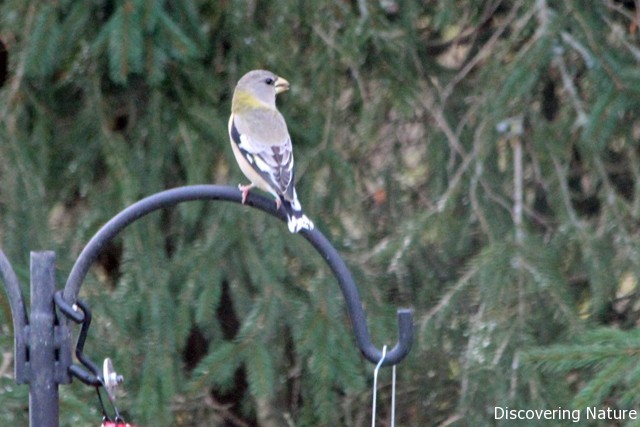
Evening grosbeak Other transients include the white-throated sparrows that scratch around below the feeders, ground-feeding.
They’re seldom still, and our windows aren’t the cleanest. I love these plump sparrows, though.
We’ve had red-breasted nuthatches come through too — gorgeous little birds that I never saw before this year. And we have our usual crowd of cardinals, chickadees and titmice, house finches and goldfinches. Mourning doves and bluejays try to get their share too, making a big mess for the ground feeders to clean up.
Then there are the least welcome visitors.

Hmmmm…. 
Ready, set… 
GO! -
Morning magic
This morning I took an early morning walk in the woods. The air was alive with birdsong, and at one point I found myself lured up a trail by the voice of a brown thrasher. This is a bird I’ve just started noticing this year, and its unbroken chatter always makes me smile. It’s the first bird that’s ever tempted me to use the word “loquacious.”
I never did get my eye on the thrasher. But as I neared a bend in the trail, I heard a sudden, panicked snort, followed by thudding and swishing bushes. I’d started a deer.
Rounding the bend, I saw something that startled me: something brown and flattened-looking in the trail. A few steps closer, I saw spots. A fawn. It lay at an awkward angle, and I assumed it was dead. Wondering if I’d interrupted a coyote just starting its breakfast, I reached for my Mace (always carried, never used) and considered turning around. But what if it was not dead, only injured? I couldn’t walk away till I made sure.
A little closer, and I saw that it was breathing.
I remembered the stories I’d heard about fawns so conditioned to lie still where their mothers left them that they wouldn’t move out of the path of an oncoming combine. Horrible. Yet if these stories were true, it was no real wonder that the fawn didn’t move when I approached. I walked carefully past it, thinking the gentlest and most encouraging thoughts I could, and resisting the temptation to stroke its head. It remained motionless the whole time.

Using a zoom here -- I wasn't sticking my camera right under the little creature's nose. No word seems right to describe the experience.
Later, I read what I could find about white-tailed deer and their fawns (here and here, for starters). I felt reassured that this little fawn was just doing what white-tails do, right down to its awkward position in the grass. I read that the does leave their new fawns in places with low vegetation, and there they lie, heads flattened down as much as possible. The youngest ones remain motionless even when another animal comes close. If there are two or three fawns, the doe will hide them in separate places.
This morning, with only the combine stories in mind to support the notion that the fawn was behaving normally, I walked on down the trail and then waited a minute to see if the doe returned. She had made a wide circle, and through the brush on the other side of the trail from where she’d run away, she came haltingly.
That’s her, flaring her nostrils in another loud snort of alarm at the sight of me. Not wanting to bother this little family unit any further, I headed off.
I couldn’t help but notice the music coming from the surrounding woods. As a lullaby for a young deer, it was superior to any mobile I ever found for my daughters. I recorded a few of the songs, and the sound quality is all right though my video skills are dismal. (I wish I knew how to record sound without video.)
There was the thrasher, who continued endlessly with his one-sided conversation.
Somewhere, a veery sang — a bird I’ve never seen, but whose song I’ve come to recognize. To me, it’s a sound that belongs to secluded places.
And a thrush — I think a hermit thrush, but maybe a wood thrush — sang its lonesome and lovely song. At around the halfway point, the snorts of another startled deer (or two) that had spotted me can be heard.
There were other sights and sounds too, but the fawn was the highlight. One source I looked at said that fawns who survive their first week of life stand a good chance. I’m pulling for you, little one.









